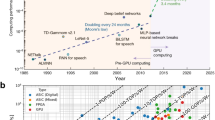Abstract
Computing hardware systems based on memristors can eliminate the data shuttling between the memory and processing units, offer massive parallelism, and hence promise substantial boost in computing throughput and energy efficiencies. However, such non-von Neumann computational approach imposes high requirements on specific characteristics of memristive devices. In this chapter, we first describe the electrical behavior of our newly developed Ta/HfO2 memristor, in particular, how it meets most requirements for in-memory computing in artificial neural networks. We then examine the underlying mechanism of this device by using electrical and physical characterizations, and attribute the resistance switching to the composition modulation of conduction channel(s) through motion of both cation and anions. Finally, we showcase large-scale one-transistor-one-resistance switch (1T1R) arrays fabricated by integrating the Ta/HfO2 memristors with foundry-made metal–oxide–semiconductor transistors, and their applications in artificial neural networks and hardware security.
Access this chapter
Tax calculation will be finalised at checkout
Purchases are for personal use only
Similar content being viewed by others
References
**a Q, Yang JJ (2019) Memristive crossbar arrays for brain-inspired computing. Nat Mater 18:309–323
Zidan MA, Strachan JP, Lu WD (2018) The future of electronics based on memristive systems. Nat Electron 1:22–29
Ielmini D, Wong HSP (2018) In-memory computing with resistive switching devices. . 1:333–343
Yu S (2018) Neuro-inspired computing with emerging nonvolatile memory. Proc IEEE 106(2):260
Sebastian A, Gallo ML, Khaddam-Aljameh R, Eleftheriou E (2020) Memory devices and applications for in-memory computing. Nat Nano
Chua LO (1971) Memristor-the missing circuit element. IEEE Trans Circuit Theory 18(5):507–519
Strukov DB, Snider GS, Stewart DR, Williams RS (2008) The missing memristor found. Nature 453:80–83
Yang JJ, Strukov DB, Stewart DR (2013) Memristive devices for computing. Nat NANO 8(1):13
Prezioso M et al (2015) Training and operation of an integrated neuromorphic network based on metal-oxide memristors. Nature 521:61–64
Yao P et al (2017) Face classifcation using electronic synapses. Nat Commun 8:15199
Li C et al (2018) Analogue signal and image processing with large memristor crossbars. Nat Electron 1:52–59
Li C et al (2018) Efficient and self-adaptive in-situ learning in multilayer memristor neural networks. Nat Commun 9:2385
Li C et al (2019) Long short-term memory networks in memristor crossbar arrays. Nat Mach Intell 1:49–57
Hu M et al (2018) Memristor-based analog computation and neural network classifcation with a dot product engine. Adv Mater 30:1705914
Sheridan PM et al (2017) Sparse coding with memristor networks. Nat Nanotechnol 12:784–789
Wang Z et al (2018) Capacitive neural network with neuro-transistors. Nat Commun 9:3208
Wang Z et al (2017) Memristors with difusive dynamics as synaptic emulators for neuromorphic computing. Nat Mater 16:101–108
Wang Z et al (2019) Reinforcement learning with analogue memristor arrays. Nat Electron 2:115–124
Lin P et al (2020) Three-dimensional memristor circuits as complex neural networks. Nat Electron 3:225–232
Yao P et al (2020) Fully hardware-implemented memristor convolutional neural network. Nature 577:641–646
Wang W et al (2018) Learning of spatiotemporal patterns in a spiking neural network with resistive switching synapses. Sci Adv 4:4752
Jo SH et al (2010) Nanoscale memristor device as synapse in neuromorphic systems. Nano Lett 10:1297–1301
Wang Z et al (2018) Fully memristive neural networks for pattern classifcation with unsupervised learning. Nat Electron 1:137–145
Sun Z et al (2019) Solving matrix equations in one step with cross-point resistive arrays. Proc Natl Acad Sci USA 116:4123–4128
Du C et al (2017) Reservoir computing using dynamic memristors for temporal information processing. Nat Commun 8:2204
Jiang H et al (2017) A novel true random number generator based on a stochastic difusive memristor. Nat Commun 8:882
Gaba S, Sheridan P, Zhou J, Choi S, Lu W (2013) Stochastic memristive devices for computing and neuromorphic applications. Nanoscale 5:5872–5878
Balatti S et al (2016) Physical unbiased generation of random numbers with coupled resistive switching devices. IEEE Trans Electron Dev 63:2029–2035
Nili H et al (2018) Hardware-intrinsic security primitives enabled by analogue state and nonlinear conductance variations in integrated memristors. Nat Electron 1:197
Jiang H et al (2018) A provable key destruction scheme based on memristive crossbar arrays. Nat Electron 1:548
Fleischer B, et al (2018) A scalable multi- teraOPS deep learning processor core for AI trainina and inference. In: IEEE symposium on VLSI circuits, pp 35–36
Jiang H et al (2016) Sub-10 nm Ta channel responsible for superior performance of a HfO2 memristor. Sci Rep 6:28525
Chakrabarti S, Samanta S, Maikap S, Rahaman SZ, Cheng HM (2016) Temperature-dependent non-linear resistive switching characteristics and mechanism using a new W/WO3/WOx/W structure. Nanoscale Res Lett 11:389
Wang ZR et al (2017) Memristors with diffusive dynamics as synaptic emulators for neuromorphic computing. Nat Mater 16:101–108
Yang JJ et al (2008) Memristive switching mechanism for metal/oxide/metal nanodevices. Nat Nano 3(7):429
Miao F, et al (2011) Anatomy of a nanoscale conduction channel reveals the mechanism of a high‐performance memristor 23(47):5633–5640
Munstermann R et al (2010) Morphology and electrical changes in TiO2 memristive devices induced by electroforming and switching. Phys Status Solidi-Rapid Res Lett 4:16–18
Yang JJ, et al (2009) The mechanism of electroforming of metal oxide memristive switches. Nanotechnology 20:215201
Wedig A et al (2016) Nanoscale cation motion in TaOx, HfOx and TiOx memristive systems. Nature Nano 11:67–74
Sheng X et al (2019) Low-conductance and multilevel CMOS-integrated nanoscale oxide memristors. Adv Electron Mater 5:1800876
Author information
Authors and Affiliations
Corresponding author
Editor information
Editors and Affiliations
Rights and permissions
Copyright information
© 2022 Springer Nature Switzerland AG
About this chapter
Cite this chapter
Jiang, H., Li, C., Lin, P., Wang, Z., Yang, J.J., **a, Q. (2022). Ta/HfO2-based Memristor and Crossbar Arrays for In-Memory Computing. In: Chua, L.O., Tetzlaff, R., Slavova, A. (eds) Memristor Computing Systems. Springer, Cham. https://doi.org/10.1007/978-3-030-90582-8_8
Download citation
DOI: https://doi.org/10.1007/978-3-030-90582-8_8
Published:
Publisher Name: Springer, Cham
Print ISBN: 978-3-030-90581-1
Online ISBN: 978-3-030-90582-8
eBook Packages: EngineeringEngineering (R0)




